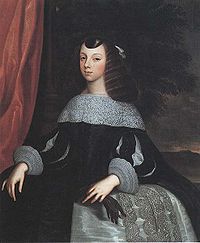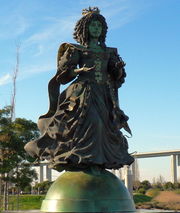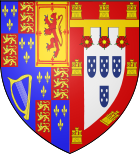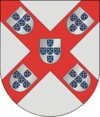Catherine of Braganza
| Catherine of Braganza | |
|---|---|
 |
|
|
|
|
| Tenure | 23 April 1662 – 6 February 1685 |
| Spouse | Charles II of England |
| Full name | |
| Catherine Henrietta Portuguese: Catarina Henriqueta de Bragança |
|
| House | House of Stuart (by marriage) House of Braganza (by birth) |
| Father | John IV of Portugal |
| Mother | Luisa of Medina-Sidonia |
| Born | 25 November 1638 Vila Viçosa, Portugal |
| Died | 31 December 1705 (aged 67) Bemposta Palace, Lisbon, Portugal |
| Burial | Jerónimos Monastery, Belém, Lisbon |
Catherine of Braganza (Catarina de Bragança, in Portuguese) (25 November 1638 – 31 December 1705) was a Portuguese Infanta and the queen consort of Charles II of England, Scotland and Ireland.
She married the king in 1662. In the beginning of her tenure as queen consort, she was not popular with the English people, due to her Catholic religion and inability to speak the English language. Part of her dowry were the port cities of Tangier and Bombay.
As none of her pregnancies produced surviving offspring, the throne passed to Charles' brother James, Duke of York. Her husband kept many mistresses and fathered numerous illegitimate offspring which he acknowledged.
Contents |
Early life

Infanta Catarina of Portugal (or of Braganza) was born in Vila Viçosa as the second surviving daughter of John IV of Portugal (at the time Duke of Braganza) and his wife, Luisa de Guzmán, a daughter of the duke of Medina-Sidonia. Through her mother, Catherine was a 3rd great granddaughter of Saint Francis Borgia. Although she was raised in a convent, Catherine's upbringing and education were closely supervised by her mother.
Following the restoration of the Portuguese Royal House, and her father's accession to the throne on 1 December 1640, she was proposed as a bride for John of Austria, François de Vendôme, duc de Beaufort, Louis XIV and Charles II. She was seen as a useful conduit for contracting an alliance between Portugal and England, after the Treaty of the Pyrenees in 1659 in which Portugal was arguably abandoned by France. Upon Charles's restoration to the English throne in 1660, Catherine's mother reopened negotiations with his counsellors, and a marriage treaty was signed 23 June 1661.
As Queen Consort
She was married by proxy in Lisbon on 23 April 1662. After arriving in Portsmouth on 14 May 1662, the couple were married in two more ceremonies – a Catholic one conducted in secret, followed by a public Anglican service – on 21 May. Catherine married at the age of 23.
Her large dowry brought the port cities of Tangier and Bombay (now Mumbai) to British control. The former had only a transitory significance, but the latter had a major lasting influence on the development of the British Empire and the History of India, as the British would develop Bombay - which had only 10,000 inhabitants under the Portuguese - into a major centre of commerce.
At the time, she was not a particularly popular choice of queen, being Roman Catholic, and her religion prevented her from being crowned, as Roman Catholics were forbidden to take part in Anglican services. She initially faced hardships due to the language barrier, the king's infidelities and the political conflicts between Roman Catholics and Anglicans. Over time, her quiet decorum, loyalty and genuine affection for Charles changed the public's perception of her.
Catherine became pregnant and miscarried at least twice, and during a severe illness in 1663, she thought, for a time, she had given birth. Charles comforted her by telling her she had indeed given birth to two sons and a daughter. Her position was a difficult one, as Charles continued to have children by his many mistresses, but insisted she be treated with respect, and sided with her over his mistresses when he felt she was not receiving the respect she was due.
Throughout his reign, he firmly dismissed the idea of divorcing Catherine, even when Parliament exerted pressure to beget or declare a Protestant successor.
Though known to keep her faith a private matter, her religion and proximity to the king made her the target of anti-Catholic sentiment. In 1678, the murder of Sir Edmund Godfrey was ascribed to several of her servants. In November of the same year she was accused by Titus Oates, an instigator of the "Popish Plot", of being part of a conspiracy to poison the king, even though Charles himself disbelieved the entirety of the plot. Although both the evidence in her case and the Popish Plot were later discovered to be fabrications, the House of Commons voted unsuccessfully for an address calling for the Queen and her household to be banished from Whitehall. In 1679 she was defended against the allegations by the king himself.
Later years
At Charles' final illness in 1685 she showed anxiety for his reconciliation with the Roman Catholic faith, and exhibited great grief at his death. Later in the same year, she unsuccessfully interceded with James II for the life of James Scott, 1st Duke of Monmouth, Charles's illegitimate son and leader of the Monmouth Rebellion - even though Monmouth in rebellion had called upon the support represented by the staunch Protestants opposed to the Catholic Church.
Catherine remained in England, living at Somerset House, through the reign of James and his deposition in the Glorious Revolution by William III and Mary II.
Initially on good terms with William and Mary, her position deteriorated as the practice of her religion led to misunderstandings and increasing isolation. A bill was introduced to Parliament to limit the number of Catherine's Catholic servants, and she was warned not to agitate against the government. She finally returned to Portugal in March 1692.
She supported the Treaty of Methuen in 1703 with England and acted as regent for her brother, Peter II, in 1701 and 1704-05. She died at the Bemposta Palace in Lisbon on 31 December 1705 and was buried at the Jerónimos Monastery, in Belém, Lisbon.

Historical and cultural impact
Catherine introduced the custom of drinking tea in England, a custom that was already very popular among the Portuguese nobility at the time. The tea had been imported to Portugal from the Portuguese possessions in Asia as well as through the trade Portuguese merchants maintained with China and Japan.
According to the Museum Director of the house of Braganza, it was not only drinking tea but "High Tea" at 16:00 (some people believe it to be at 17:00) which is still a Portuguese tradition. Catherine also introduced the fork to the dining tables of England.
Although some have claimed that Queens, a borough of New York City, was named after Catherine of Braganza, her name is not mentioned in the first 200 years of historical documents that have been preserved in the county archives. She was, however, queen when Queens County was established, alongside Kings County (Brooklyn) in 1683. Kings County was named for her husband, King Charles II.
Because it was alleged that the Queen and her family had profited from the slave trade, a recent effort to build a 10 m (33 ft)-tall statue in her honour in Queens was defeated by local African American, Irish-American and community groups.[1] A quarter-scale model survives at the site of Expo '98, in Lisbon, Portugal, facing Queens across the Atlantic.
Titles and arms
Titles

- 25 November 1638–1 December 1640: Dona Catarina de Bragança
- 1 December 1640–17 November 1653: Her Highness The Infanta Dona Catarina
- 17 November 1653–23 April 1662: Her Royal Highness The Princess of Beira
- 23 April 1662–6 February 1685: Her Majesty The Queen of England, Scotland and Ireland
- 6 February 1685–31 December 1705: Her Majesty The Queen Dowager of England, Scotland and Ireland
Arms
The Royal Coat of Arms of the United Kingdom are impaled with the arms granted to her as the 2nd Princess of Beira.
Ancestry
|
|
|
|
|
|
|
|
|
|
|
|
|
|
|
|
|
John I, Duke of Braganza | ||||||||||||
|
|
|||||||||||||
|
|
|
|
|
|
|||||||||
|
|
Teodósio II, Duke of Braganza |
|
|||||||||||
|
|
|||||||||||||
|
|
|
|
|
|
|
|
|
||||||
|
|
Infanta Catarina, Duchess of Braganza | ||||||||||||
|
|
|||||||||||||
|
|
|
|
|
|
|||||||||
|
|
John IV of Portugal |
|
|||||||||||
|
|
|||||||||||||
|
|
|
|
|
|
|
|
|
|
|
|
|||
|
|
Juan Fernández de Velasco, Duke of Frias | ||||||||||||
|
|
|||||||||||||
|
|
|
|
|
|
|||||||||
|
|
Ana de Velasco y Girón |
|
|||||||||||
|
|
|||||||||||||
|
|
|
|
|
|
|
|
|
||||||
|
|
Ana Ángela de Aragón y Guzmán | ||||||||||||
|
|
|||||||||||||
|
|
|
|
|
|
|||||||||
|
|
Catherine of Braganza |
|
|||||||||||
|
|
|||||||||||||
|
|
|
|
|
|
|
|
|
|
|
|
|
|
|
|
|
Alonso de Guzmán El Bueno, Duke of Medina-Sidonia | ||||||||||||
|
|
|||||||||||||
|
|
|
|
|
|
|||||||||
|
|
Juan Manuel de Guzmán El Bueno, Duke of Medina-Sidonia |
|
|||||||||||
|
|
|||||||||||||
|
|
|
|
|
|
|
|
|
||||||
|
|
Ana de Sylva y Mendoza | ||||||||||||
|
|
|||||||||||||
|
|
|
|
|
|
|||||||||
|
|
Luisa de Guzmán |
|
|||||||||||
|
|
|||||||||||||
|
|
|
|
|
|
|
|
|
|
|
|
|||
|
|
Francisco Goméz de Sandoval y Rojas, Duke of Lerma | ||||||||||||
|
|
|||||||||||||
|
|
|
|
|
|
|||||||||
|
|
Juana Lourença Gómez de Sandoval y la Cerda |
|
|||||||||||
|
|
|||||||||||||
|
|
|
|
|
|
|
|
|
||||||
|
|
Catarina de Lacerda | ||||||||||||
|
|
|||||||||||||
|
|
|
|
|
|
|||||||||
References
- ↑ Catherine Of Braganza: The Fall Of A Queen, Queens Tribune
- Fraser, Antonia (1979). King Charles II
External links
- Britannia.com Catherine of Braganza
|
Catherine of Braganza
Cadet branch of the House of Aviz
Born: 25 November 1638 Died: 31 December 1705 |
||
| British royalty | ||
|---|---|---|
| Vacant
Title last held by
Henrietta Maria of France |
Queen Consort of England and of Ireland 1662–1685 |
Succeeded by Mary of Modena |
| Queen Consort of Scots 1662–1685 |
||
|
|||||
|
|||||
|
||||||||||||||||||||||||||||||||||||||||||||||||||||||||||||||||||||||||||||||||||||||||||||||||
|
||||||||||||||||||||||||||||||||||||||||||||||||||||||||||||||||||||||||||||||||||
